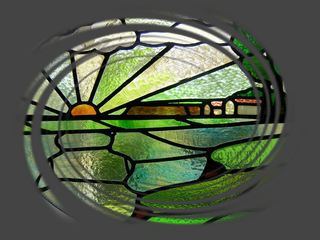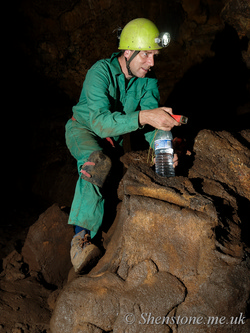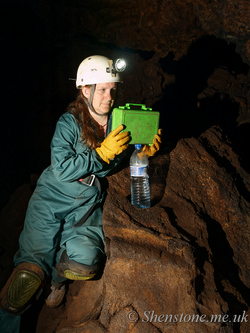 |
Tenerife Lava Tubes |
 |
Tenerife Lava Tubes |
These photographs are taken on the Wessex Cave club trip to Tenerife in 2012 organised by Dr Andy Morse of the Open University Department of Physical Sciences
The tubes visted are part of, or related to, Cueva del Viento which we were able to visit through the excellent and friendly support of Alfredo Concepción and his colleagues who looked after us so well above ground and in the taverna where we recovered later
The Cueva del Viento and cueva del Sobrado system is currently the 5th longest Lava Tube in the world and is over 10 miles (17km) long with a depth of nearly 1900 ft (560m) from it's highest point currently explored to the lowest point.
 In Felipe Reventon we were surveying the tube to obtain a more accurate position for the current known end of the tube and determine its relation to other known tubes in the area in the hope of being able to join them up and create a larger known system and to be able to understand the science of the system more fully.
In Felipe Reventon we were surveying the tube to obtain a more accurate position for the current known end of the tube and determine its relation to other known tubes in the area in the hope of being able to join them up and create a larger known system and to be able to understand the science of the system more fully.
In these Pictures you can see the survey team of Andy Morse, Carmen Smith and Rhian Kendall using the latest in electronic underground surveying equipment which is a laser measuring device (Disto) with additional built in compass and inclinometer (clinometer) which was a valuable piece of equipment as it really speeds up the measurements.
The DistoX as this variant is known is best fired at a flat relective target which allows for vibility of the red dot and confidence in what has been measured (relying on the passage walls would be uneven and give unreliable results.)
 In Felipe Reventon we were surveying the tube to obtain a more accurate posialt="Rhian Kendall using a Pelibox as a target for the DistoXcave surveying device" >
You will also note the plastic bottles these were also an important piece of the surveying equipment as the rocks are magnetic and the distance from the rock to the top of the bottle really helps in minimising the magnetic effects.
The effect of localised magnetic fields drops off as the suare of distance so even the 30 cm or so of a bottle can allow for more accurate readings.
In Felipe Reventon we were surveying the tube to obtain a more accurate posialt="Rhian Kendall using a Pelibox as a target for the DistoXcave surveying device" >
You will also note the plastic bottles these were also an important piece of the surveying equipment as the rocks are magnetic and the distance from the rock to the top of the bottle really helps in minimising the magnetic effects.
The effect of localised magnetic fields drops off as the suare of distance so even the 30 cm or so of a bottle can allow for more accurate readings.
Even with this precaution however there were some noteable variances measured when the same leg (from bottle to bottle) was measured. To allow these effects to be minimised even further each leg was measured both forwards and backwards allowing the data to be post processed looking for those stations where a more signficant difference has been noted and in these cases either the forewards or back measurement can be preferred to get the most accurate position
Whilst these devices can be integrated with computers for paperless surveying a notebook was used in this work. The survey notebook making a useful reflective target.
The team of three surveyors with 2 targets and 2 or 3 plastic bottles proved to be very effective in taking readings and allowed the work to be completed in a reasonable time

In geological terms Lava tubes differ from caves in that they are formed by molted rock and not by the erosion of water.
Because of this they tend to (but are not limited to) having a standard slope of about 12-14 degrees depending on the type of lava erupted and therefore its viscosity and the steepness of the ground over which it travels.
Basaltic lava is runnier than lava's containing more silica which tend to be more viscous and therefore most tunes are in basaltic or near basaltic lava's
Some aspects of the tubes are primary in that they are formed by the intiial flow and crusting over with lava simply running in strightforward tubes beneath this surface.
Other aspects are created in a much more complex manner such as erosional flow where existing solidified lava is removed by fresh hot molten rock running across it,
or sections where complex paths have been created by softening and tubes branching and joining.
In my opinion Cueva del Viento shows many of the more complex features, but there is still a lot more of the system that I have not seen and I will have to visit in future years.

The tubes do have life and we saw a large number of tree roots and dead rabbits in some passages - one of the dead baby rabbits in Cueva del Viento was so fresh it still had it's fur on. Almost certainly these get washed in at times of rain or some in from small entrances that we humans cannot get though.
There are also tree roots coming down the many cooling racks in the lava above the tube which are seeking out the moisture that condenses on the walls. These usually cling to the walls, but when they reach large passages they often cannot do this and instead form large vertical curtains across the passage.
Other members of the team who joined us and assisted in many ways during these trips and in the general event were Wendy Bollard, Ian Timmey, John (Tommo) Thomas, Ed Waters and Hayley Clark, and in Tenerife Alfredo lainez and Uca Diaz joined us underground, and we met other members of the team such as Dragan Milekovic and Connie? out there. and worked with them to get their cave surveying software (survex ) working on their laptop. which was a most intesting expereince working with spanish speaking guys on a German copies of Windows when I speak neither. Good job Dragan's english was up to it
Some useful resources on lava tubes and volcanoes if you want to read more are: -
The Virtual Lava Tube on Dave Bunnell's excellent Virtual Cave site
How Volcanoes Work an educational resource that describes the science behind volcanoes and volcanic processes sponsored by NASA
USGS Lava Tubes and Lava Tube Caves Pages includes Lava Flows, Ape Cave, Mount St. Helens, Indian Heaven Volcanic Field, Lava River Cave, Mauna Ulu, Kilauea (Hawaii), Medicine Lake and Lava Beds ... which are many places I would like to visit
The Worlds Longest Lava tube list by Caver Bob of the NSS
The Caves of Tenerife page on the excellent
Caves of Lanzarote website
All of these pictures were taken with an Olympus E-510 camera with the kit 14-42 lens. The photographs in Felipe Reventon are lit with a single FL-36 Flashgun directly connected to the camera via a spiral cable. The use of the spiral flash Synch cable is to allow the flast to be away from the camera to reduce misting which is bad when the flash is next to the lens. This is not the best for artistic underground photography as it can lead to flat looking pictures with poor shadows unless you have a long arm or the object is close, but it is reliable and fast which is what you need to be when you are photographing people who are working such as the survey team here.
Those taken in Cueva del Viento (Breveritas Entrance) are taken with the same camera and lens, but with remote wireless flash triggers and multiple FL-36 flashguns being used in some pictures. This allows the flash to be well away from the lens, even more reduction of misting and more creative lighting
For more information on cave geology and cave formations please take a look at the Cave Geology page
For more information on caving please take a look at the links page